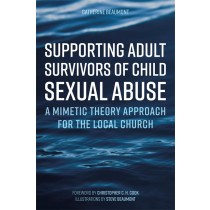We hosted the launch of Catherine Beaumont’s book on 1st September, Supporting Adult Survivors of Childhood Sexual Abuse: A Mimetic Theory Approach for the Local Church, available from Jessica Kingsley here. Rev Dr Susan Shooter, author of ‘How Survivors of Abuse Relate to God: the Authentic Spirituality of the Annihilated Soul’, gave a response to Catherine’s book at the launch, commending the book unreservedly.
Catherine’s book is for anyone involved in local churches, engaged in pastoral care or church leadership. It shows how churches can change behaviour towards adult survivors of sexual abuse to foster healthier, more inclusive communities for the benefit of all. The book includes stories based on real life experiences, which offer hope and guidance to enable the reader to imagine change in their own church.
Imagine you just woke up from a nightmare. Everything is dark. You think everything will be alright again in a minute or two, but… it remains dark. There’s nothing you can feel around you that’s familiar, so you get up and walk around. You touch a wall; you follow its contours to search for a light switch. You can’t find one. But you do find a door. You try the handle. The door is locked. You shout for help. No one comes. You remain alone in the blackness. Hours. Maybe days. You think you might die.
Then, a slice of light appears beneath the door.
‘Help,’ you cry out, ‘I’m in here in the dark, all alone.’
A voice speaks kindly. ‘I’ll help you.’ The door handle rattles. It doesn’t open. The light fades. The person disappears. This happens over and over again.
‘Look,’ they say, ‘you’re just not trying to get out. Try harder.’
‘But it’s locked, on your side,’ you say.
‘It’s not locked. Try opening it properly and you’ll see you’re really free and Jesus loves you. Can’t you see I’m trying to help you?’
Alone again in the darkness, you think you’re never going to get out.
Then, there’s a slow tip-tapping. Brick by brick the walls around you are dismantled and you’re standing in the same light as everyone else. And everyone else around you is looking … how are they looking? I’ll leave that question for you to answer for yourself when you’ve read this book.
With Supporting Adult Survivors of Child Sexual Abuse, Dr Catherine Beaumont has achieved an enormous feat of courage and patience. Painstakingly, she has chiselled away at every brick in the wall that the church has built to keep at bay those who are seen as problematic; those who remind us that all is not well; no doubt you might find on the church side of the wall notices saying “possessed” or “mentally ill”, because on the dark side are people who don’t, can’t, won’t fit our categories. Catherine maintains, a church that continues to model itself on a God who judges people by human standards, will always scapegoat those who don’t fit, side-line people who show us we are not as squeaky clean as we would have everyone believe.
Survivors are particularly problematic because as James Poling wrote in The Abuse of Power: A Theological Problem (Abingdon; 1991), the healing process for survivors leads them to the edge of chaos “where the awareness of death and nothingness is fully present.” They have no option but to face darkness.
Catherine’s powerful vision for vindicating rather than scapegoating the abused takes us through a theoretical approach, but it is also based in the down-to-earth, messy experience of what surviving sexual abuse means—and not just for survivors, but for us all. Using René Girard’s Mimetic theory, Catherine shows how the Gospel God has been displaced by a mythic God who is certainly not the lover of our souls. Instead, Catherine offers us God who is not our rival and judge, who doesn’t set us up to fail so can He lord it over us, who doesn’t blame us when we do fail.
God truly is the God who never comes against us.
If survivors are to be seen as they are, not as we want them to be, pastors also need to model this non-competitive love. On page 79 she writes:
“Survivors are often told that their relationship with God is inadequate or faulty, and a good deal of pastoral care involves instructions on how to improve this. I believe all such approaches stem from the wrong understanding of the nature of God; it is actually impossible to have a distorted relationship with God, because God will never be our enemy or our rival.”
The book resonated especially with my own work in this field when Catherine picks up the issue of boundary-less-ness in spirituality. She explains that in an intense experience of a malevolent Other—a nightmarish moment of a violent encounter—a victim loses all sense of self and is caught up in the identity of the abuser. Such an intense encounter can also happen with God—the benevolent Other— who wants only good for us: this can happen in advanced spiritual practice, and in this case, boundary-less-ness happens in an unconditional love encounter with God: this brings healing. Hence, Catherine writes, “it is important that this is the God survivors find in our churches rather than the false god of rivalry” (p.51).
Taking this further, in chapter 5, Renewal, she speaks of the universality of the need for healing:
“If, in our churches, we worshipped the God revealed and imitated by Jesus, and did not block access to this God by inserting either ourselves or the capricious god of the fall narrative in the place of the [sic] model, then our churches would be places of healing for all. The healing that comes from imitation of a benevolent model is necessary for, and available to, all who have been previously formed in rivalry and conflict; it does not require the survivor to do anything that other members of the Church are not doing. We are all in need of this healing” (pp.75-6).
This leads to another issue that resonates with me. Catherine looks at how those involved in pastoral ministry need to learn from survivors what that ministry should look like. She picks up my criticism of when survivors are encouraged to identify with the sufferings of Jesus and are pressurised as individuals to suffer in silence or sacrifice themselves on behalf of others. Then she goes a step further regarding our response to the abused. She writes:
“Rather than expecting survivors to emulate Christ in the way they bear their suffering, I would like instead, to offer that same encouragement to the wider Church.
“We preach Christ crucified and encourage individual Christians to embrace the Way of the Cross. For the Church collectively this may mean being judged and condemned by the world while remaining silent in the face of this judgement, just as Jesus remained silent when he was condemned, and just as many survivors have for so long borne judgment and exclusion in silence.
“The IICSA found, within churches, an overriding concern with protecting reputation and assets, but any church willing to follow Christ to the Cross must be prepared to lose both assets and reputation. In the Sermon on the Mount Jesus calls us to stand among, and identify with, the reviled and the accused. Wherever that call is answered, the scapegoat mechanism will be disabled.
“The church that is serious about supporting survivors must begin, then, by giving up any claims to power, influence or righteousness. It must forget about protecting assets and reputation and become truly vulnerable and marginal, to the point of death, if necessary. A church that is afraid of death has little to offer and dilutes the Gospel message of resurrection” (p.104).
My last point is to say that, in showing what survivors bring to the surface in their healing journey, the way of healing is shown not just for the whole church but also the wider context of our society. When you hear the following words from page 79, bear in mind that our consumerist, capitalist society is built on competition and rivalry:
“Rivalry is a result of the natural human behaviour of imitation – when we imitate a model, we imitate their desires, and where the object of desire is limited, model and imitator find themselves in competition. God, as a model, mediates desires for those things that are not limited – a relationship with God and the fruits of that relationship are equally and abundantly available to all without limit. When God is our model, we can all pursue, and achieve, the same goals without any need for competition, and we can find a sense of belonging that does not rely on the establishment of insiders and outsiders.”
To conclude: Although the book was a challenging read, I was left at the end feeling uplifted, hopeful and renewed. It is not just as a theologian, but as a survivor of Child Sexual Abuse that I want to commend this book to you unreservedly: In Catherine someone has come along, dismantled more bricks and is offering not only me and survivors, but the church and the world, more light to our path.

